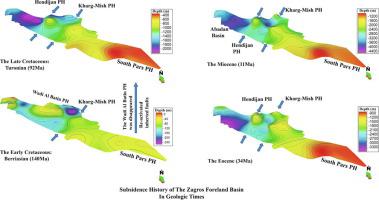当前位置:
X-MOL 学术
›
J. Asian Earth Sci.
›
论文详情
Our official English website, www.x-mol.net, welcomes your
feedback! (Note: you will need to create a separate account there.)
Tectonic evolution of the Zagros foreland basin since Early Cretaceous, SW Iran: Regional tectonic implications from subsidence analysis
Journal of Asian Earth Sciences ( IF 2.7 ) Pub Date : 2020-12-01 , DOI: 10.1016/j.jseaes.2020.104550 Hamid Reza Karimnejad Lalami , Hossein Hajialibeigi , Shahram Sherkati , Mohammad Hossein Adabi
Journal of Asian Earth Sciences ( IF 2.7 ) Pub Date : 2020-12-01 , DOI: 10.1016/j.jseaes.2020.104550 Hamid Reza Karimnejad Lalami , Hossein Hajialibeigi , Shahram Sherkati , Mohammad Hossein Adabi

|
Abstract Subsidence analysis of 42 exploration wells in the Zagros foreland basin indicates the tectonic evolution of the basin since Early Cretaceous. The impact of inherited basement structures on the basin evolution is documented in this study. Subsidence maps show that the architecture of the basin dramatically changed during the Cretaceous. In the Central Zagros, the Hercynian palaeo-high (i.e. Wadi Al Batin palaeo-high), which affected sedimentation until the Early Cretaceous time gradually disappeared and the South Pars palaeo-high within the central Persian Gulf started to show more impact on sedimentation. The palaeo-highs in the Zagros basement have different geometrical characteristics and origin. The Hercynian and South Pars are wide-wavelength palaeo-highs with a regional-scale impact on subsidence. In contrast, the Hendijan, Kharg-Mish and Kazerun palaeo-highs with different orientations and quite smaller wavelengths show different impact on the subsidence pattern. These kinds of palaeo-highs could be related to re-activation of pre-existing basement faults. Whereas South Pars and Hercynian paleo highs are possibly related to thermal expansion or contraction of the crust. The Hendijan and Kharg-Mish palaeo-highs with the NE-SW orientation were intensively re-activated during Turonian time. On the contrary, the Kazerun Fault with the N-S orientation became more active and considerably influenced sedimentation during the last 20 Ma. Selective re-activation of deep-seated faults might have taken place as a result of changes in the orientation of the far-field stress in the region. Understanding the complexities of inherited structures and their impact on reservoir characteristics can support future exploration activities in the Zagros foreland basin.
中文翻译:

伊朗西南部早白垩世以来扎格罗斯前陆盆地的构造演化:沉降分析对区域构造的影响
摘要 扎格罗斯前陆盆地42口探井的沉降分析表明该盆地早白垩世以来的构造演化。本研究记录了继承基底结构对盆地演化的影响。沉降图显示盆地的结构在白垩纪发生了巨大变化。在扎格罗斯中部,影响沉积作用直至早白垩世的海西古隆起(即 Wadi Al Batin 古隆起)逐渐消失,而波斯湾中部的南帕尔斯古隆起对沉积作用的影响开始显现。Zagros 地下室的古高地具有不同的几何特征和起源。Hercynian 和 South Pars 是宽波长的古高地,对沉降具有区域尺度的影响。相比之下,Hendijan,Kharg-Mish 和 Kazerun 古高点具有不同的方向和相当小的波长,对沉降模式的影响不同。这些类型的古高地可能与先前存在的基底断层的重新激活有关。而南帕尔斯和海西古高地可能与地壳的热膨胀或收缩有关。在图伦时期,具有 NE-SW 方向的 Hendijan 和 Kharg-Mish 古高地被强烈重新激活。相反,在过去的 20 Ma 期间,具有 NS 方向的 Kazerun 断层变得更加活跃并且显着影响了沉积。由于该地区远场应力方向的变化,可能已经发生了深部断层的选择性重新激活。
更新日期:2020-12-01
中文翻译:

伊朗西南部早白垩世以来扎格罗斯前陆盆地的构造演化:沉降分析对区域构造的影响
摘要 扎格罗斯前陆盆地42口探井的沉降分析表明该盆地早白垩世以来的构造演化。本研究记录了继承基底结构对盆地演化的影响。沉降图显示盆地的结构在白垩纪发生了巨大变化。在扎格罗斯中部,影响沉积作用直至早白垩世的海西古隆起(即 Wadi Al Batin 古隆起)逐渐消失,而波斯湾中部的南帕尔斯古隆起对沉积作用的影响开始显现。Zagros 地下室的古高地具有不同的几何特征和起源。Hercynian 和 South Pars 是宽波长的古高地,对沉降具有区域尺度的影响。相比之下,Hendijan,Kharg-Mish 和 Kazerun 古高点具有不同的方向和相当小的波长,对沉降模式的影响不同。这些类型的古高地可能与先前存在的基底断层的重新激活有关。而南帕尔斯和海西古高地可能与地壳的热膨胀或收缩有关。在图伦时期,具有 NE-SW 方向的 Hendijan 和 Kharg-Mish 古高地被强烈重新激活。相反,在过去的 20 Ma 期间,具有 NS 方向的 Kazerun 断层变得更加活跃并且显着影响了沉积。由于该地区远场应力方向的变化,可能已经发生了深部断层的选择性重新激活。











































 京公网安备 11010802027423号
京公网安备 11010802027423号